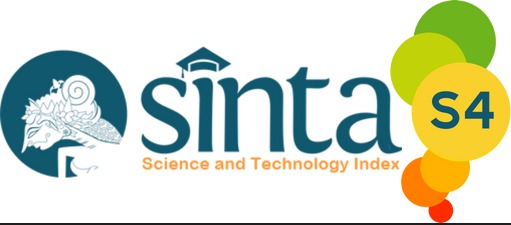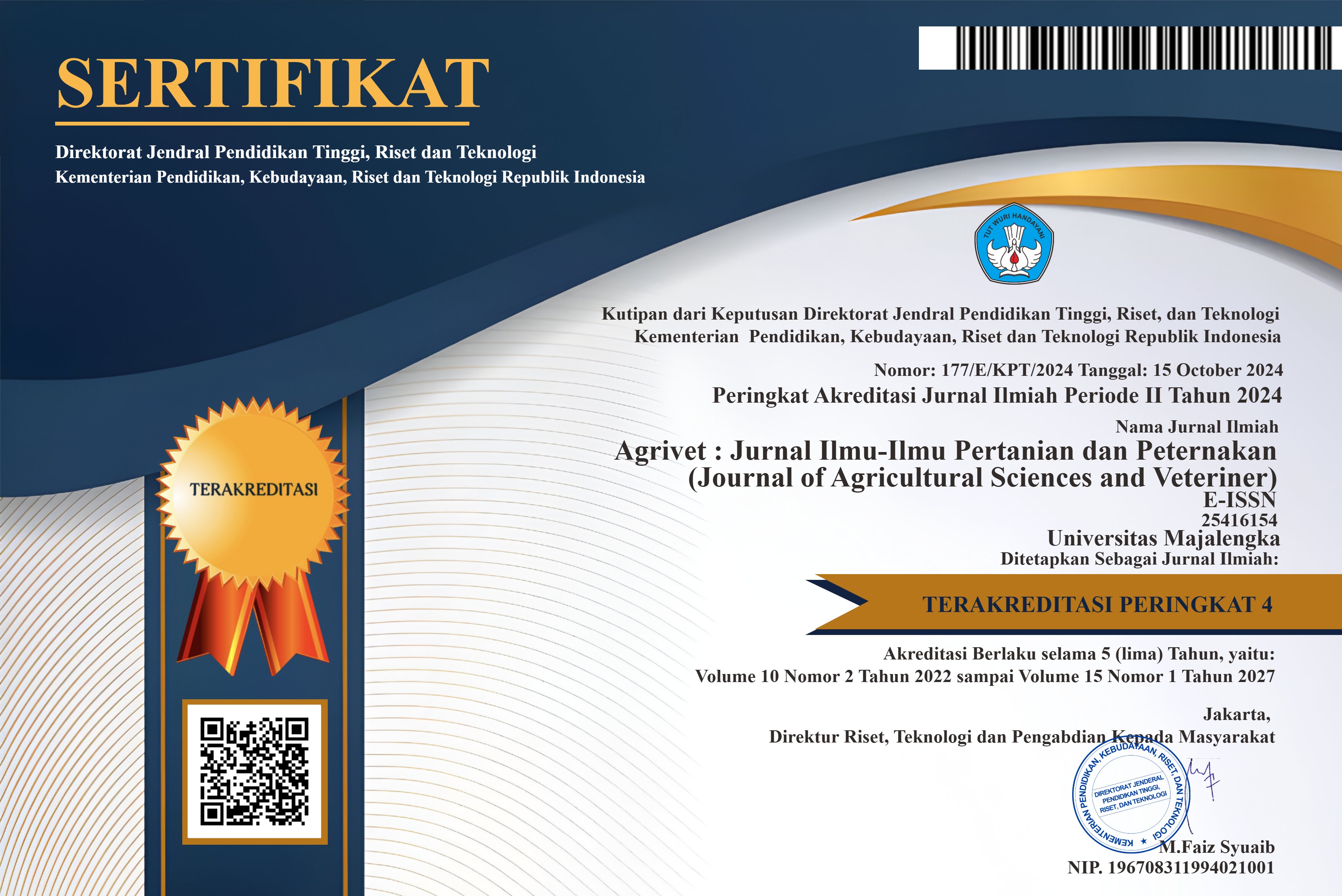Response of Eichhornia crassipes weeds to various doses of florpyrauxifen-benzyl herbicide application in cirata reservoir, Cianjur regency
English
DOI:
https://doi.org/10.31949/agrivet.v13i1.13879Abstract
The water hyacinth (E.crassipes) invasion has created a concerning ecological crisis in Cirata Reservoir, which is home to Southeast Asia's largest hydroelectric power plant and threatening the balance of freshwater ecosystems. Florpyrauxifen-benzyl herbicide emerges as a potential solution due to its high effectiveness and biodegradable nature. This study looked for to evaluate the efficacy of the herbicide containing Florpyrauxifen-benzyl in mitigating the presence of water hyacinth weeds at Cirata Reservoir, Cianjur Regency. This study utilized a Randomized Block Design containing four replications and seven treatments, including herbicide doses of 500, 750, 1000, 1250, and 1500 ml/ha, compared with hand weeding and control (without herbicide). Results showed that Florpyrauxifen-benzyl herbicide effectively suppressed water hyacinth growth up to 12 weeks after application (WAA). All tested herbicide doses resulted in lower weed biomass and weed damage percentage reaching 100% compared to control and hand weeding treatments. This study concludes that Florpyrauxifen-benzyl herbicide at doses of 500-1500 ml/ha effectively controls water hyacinth weeds in freshwater ecosystems, also providing a potential solution to the invasive aquatic weed problem at Cirata Reservoir.
Keywords:
Eichhornia crassipes, Florpyrauxifen-benzyl, Herbicide, Weed ControlDownloads
References
Djihouessi MB, Olokotum M, Chabi LC, Mouftaou F, Aina MP. 2023. Paradigm shifts for sustainable management of water hyacinth in tropical ecosystems: A review and overview of current challenges. Environmental Challenges. 11. https://doi.org/10.1016/j.envc.2023.100705
Epp JB, Alexander AL, Balko TW, Buysse AM, Brewster WK, Bryan K, Daeuble JF, Fields SC, Gast RE, Green RA, et al. 2016. The discovery of ArylexTM active and RinskorTM active: Two novel auxin herbicides. Bioorg Med Chem. 24(3):362–371. https://doi.org/10.1016/j.bmc.2015.08.011
Gaikwad RP, Gavande S. 2017. Major factors contributing growth of water hyacinth in natural water bodies. Int J Engine Res. 6(6):304–306.
Gao L, Li B, Liu WY, Shen YX, Liu WJ. 2013. Inhibition effects of daughter ramets on parent of clonal plant Eichhornia crassipes. Aquat Bot. 107:47–53. https://doi.org/10.1016/j.aquabot.2013.01.010
Grossmann K. 2007. Auxin herbicide action: Lifting the veil step by step. Plant Signal Behav. 2(5):421–423. https://doi.org/10.4161/psb.2.5.4417
Grossmann K. 2010. Auxin herbicides: Current status of mechanism and mode of action. Pest Manag Sci. 66(2):113–120. https://doi.org/10.1002/ps.1860
Gupta AK, Yadav D. 2020. BIOLOGICAL CONTROL OF WATER HYACINTH. Environmental Contaminants Reviews. 3(1):37–39. https://doi.org/10.26480/ecr.01.2020.37.39
Irwan A, Wicaksono A, Khairin FA. 2020. Identifikasi Distribusi Beban Sedimentasi pada Intake DAM dan Reservoir PLTA (Studi Kasus: PLTA Cirata, Purwakarta-Jawa Barat). JournalofAppliedScience. 2(1).
Janssens N, Schreyers L, Biermann L, Van Der Ploeg M, Bui TKL, Van Emmerik T. 2022. Rivers running green: Water hyacinth invasion monitored from space. Environmental Research Letters. 17(4). https://doi.org/10.1088/1748-9326/ac52ca
Liu C, Han Y, Teng C, Ma H, Tao B, Yang F. 2023. Residue dynamics of florpyrauxifen-benzyl and its effects on bacterial community structure in paddy soil of Northeast China. Ecotoxicol Environ Saf. 249. https://doi.org/10.1016/j.ecoenv.2022.114390
Maienfisch P, Mangelinckx S. 2021. Recent Highlights in the Discovery and Optimization of Crop Protection Products. 1st ed. [place unknown]: Academic Press Publication Elsevier.
Ministry of Energy and Mineral Resources. 2020. Pembangkit EBT Terbesar di Indonesia dan Asia Tenggara, Semua Ada di Waduk Cirata. Direktorat Jenderal EBTKE [Internet]. [accessed 2025 Feb 14]. https://www.esdm.go.id/id/berita-unit/direktorat-jenderal-ebtke/pembangkit-ebt-terbesar-di-indonesia-dan-asia-tenggara-semua-ada-di-waduk-cirata
Rezkia NN, Kurniadie D, Widayat D. 2023. The application of Florpyrauxifen-benzyl 25 g/L, a new auxin synthetic herbicide, to control and inhibit the growth of water hyacinth weed (Eichhornia crassipes (Mart). Solms). Kultivasi. 22(3). https://doi.org/10.24198/kultivasi.v22i3.45677
Richardson RJ, Haug EJ, Netherland MD. 2016. Effects of Aquatic Herbicides on Freshwater Mollusks View project Response of seven aquatic plants to a new arylpicolinate herbicide. J Aquat Plant Manag [Internet]. 54:26–31. https://www.researchgate.net/publication/299391283
Vera DYS, Turmudi E, Suprijono E. 2020. PENGARUH JARAK TANAM DAN FREKUENSI PENYIANGAN TERHADAP PERTUMBUHAN, HASIL KACANG TANAH (Arachis hypogaea L ) DAN POPULASI GULMA. Jurnal Ilmu-Ilmu Pertanian Indonesia. 22(1):16–22. https://doi.org/10.31186/jipi.22.1.16-22
Yang H, Tan T, Ren G, Liu Y, Liu Z, Xia S, Wu Z, Zhang Y. 2025. The dual nature of water hyacinth (Pontederia crassipes): Environmental threats and sustainable solutions. Water Biology and Security. https://doi.org/10.1016/j.watbs.2025.100359
Zeleke TB, Soeprobowati TR, Adissu S, Warsito B. 2024. Analysing the effect of water hyacinth (Eichhornia crassipes) invasion on water quality and trophic state of Lake Tana. Chemistry and Ecology. https://doi.org/10.1080/02757540.2024.2432886
Published
How to Cite
Issue
Section
License
Copyright (c) 2025 Nita Nur Rezkia, Denny Kurniadie, Umar Dani

This work is licensed under a Creative Commons Attribution-ShareAlike 4.0 International License.
An author who publishes in the Jurnal Agrivet agrees to the following terms:
- Author retains the copyright and grants the journal the right of first publication of the work simultaneously licensed under the Creative Commons Attribution-ShareAlike 4.0 License that allows others to share the work with an acknowledgment of the work's authorship and initial publication in this journal
- The author is able to enter into separate, additional contractual arrangements for the non-exclusive distribution of the journal's published version of the work (e.g., post it to an institutional repository or publish it in a book) with the acknowledgment of its initial publication in this journal.
- The author is permitted and encouraged to post his/her work online (e.g., in institutional repositories or on their website) prior to and during the submission process, as it can lead to productive exchanges, as well as earlier and greater citation of the published work











